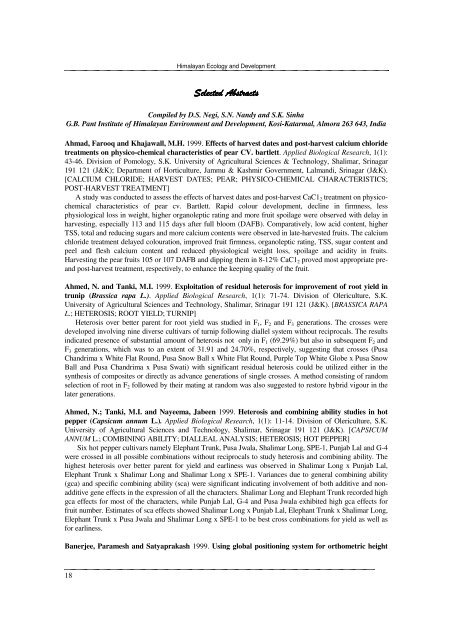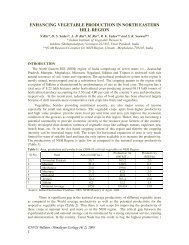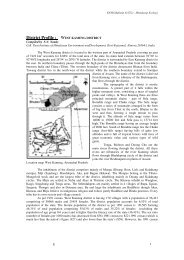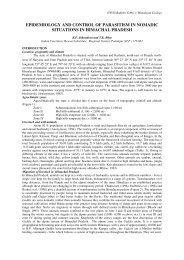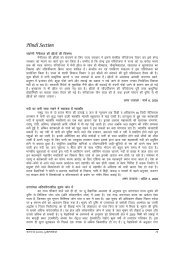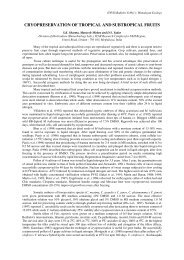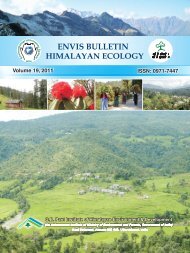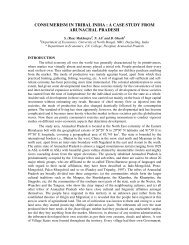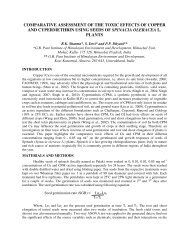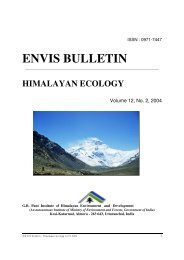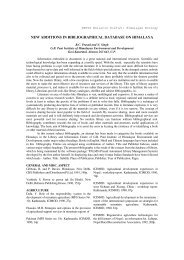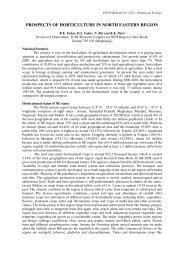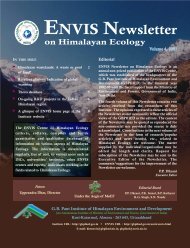Complete PDF - ENVIS Centre on Himalayan Ecology
Complete PDF - ENVIS Centre on Himalayan Ecology
Complete PDF - ENVIS Centre on Himalayan Ecology
Create successful ePaper yourself
Turn your PDF publications into a flip-book with our unique Google optimized e-Paper software.
<strong>Himalayan</strong> <strong>Ecology</strong> and Development<br />
Selected Abstracts<br />
Compiled by D.S. Negi, S.N. Nandy and S.K. Sinha<br />
G.B. Pant Institute of <strong>Himalayan</strong> Envir<strong>on</strong>ment and Development, Kosi-Katarmal, Almora 263 643, India<br />
Ahmad, Farooq and Khajawall, M.H. 1999. Effects of harvest dates and post-harvest calcium chloride<br />
treatments <strong>on</strong> physico-chemical characteristics of pear CV. bartlett. Applied Biological Research, 1(1):<br />
43-46. Divisi<strong>on</strong> of Pomology, S.K. University of Agricultural Sciences & Technology, Shalimar, Srinagar<br />
191 121 (J&K); Department of Horticulture, Jammu & Kashmir Government, Lalmandi, Srinagar (J&K).<br />
[CALCIUM CHLORIDE; HARVEST DATES; PEAR; PHYSICO-CHEMICAL CHARACTERISTICS;<br />
POST-HARVEST TREATMENT]<br />
A study was c<strong>on</strong>ducted to assess the effects of harvest dates and post-harvest CaC1 2 treatment <strong>on</strong> physicochemical<br />
characteristics of pear cv. Bartlett. Rapid colour development, decline in firmness, less<br />
physiological loss in weight, higher organoleptic rating and more fruit spoilage were observed with delay in<br />
harvesting, especially 113 and 115 days after full bloom (DAFB). Comparatively, low acid c<strong>on</strong>tent, higher<br />
TSS, total and reducing sugars and more calcium c<strong>on</strong>tents were observed in late-harvested fruits. The calcium<br />
chloride treatment delayed colourati<strong>on</strong>, improved fruit firmness, organoleptic rating, TSS, sugar c<strong>on</strong>tent and<br />
peel and flesh calcium c<strong>on</strong>tent and reduced physiological weight loss, spoilage and acidity in fruits.<br />
Harvesting the pear fruits 105 or 107 DAFB and dipping them in 8-12% CaC1 2 proved most appropriate preand<br />
post-harvest treatment, respectively, to enhance the keeping quality of the fruit.<br />
Ahmed, N. and Tanki, M.I. 1999. Exploitati<strong>on</strong> of residual heterosis for improvement of root yield in<br />
trunip (Brassica rapa L.). Applied Biological Research, 1(1): 71-74. Divisi<strong>on</strong> of Olericulture, S.K.<br />
University of Agricultural Sciences and Technology, Shalimar, Srinagar 191 121 (J&K). [BRASSICA RAPA<br />
L.; HETEROSIS; ROOT YIELD; TURNIP]<br />
Heterosis over better parent for root yield was studied in F 1 , F 2 and F 3 generati<strong>on</strong>s. The crosses were<br />
developed involving nine diverse cultivars of turnip following diallel system without reciprocals. The results<br />
indicated presence of substantial amount of heterosis not <strong>on</strong>ly in F 1 (69.29%) but also in subsequent F 2 and<br />
F 3 generati<strong>on</strong>s, which was to an extent of 31.91 and 24.70%, respectively, suggesting that crosses (Pusa<br />
Chandrima x White Flat Round, Pusa Snow Ball x White Flat Round, Purple Top White Globe x Pusa Snow<br />
Ball and Pusa Chandrima x Pusa Swati) with significant residual heterosis could be utilized either in the<br />
synthesis of composites or directly as advance generati<strong>on</strong>s of single crosses. A method c<strong>on</strong>sisting of random<br />
selecti<strong>on</strong> of root in F 2 followed by their mating at random was also suggested to restore hybrid vigour in the<br />
later generati<strong>on</strong>s.<br />
Ahmed, N.; Tanki, M.I. and Nayeema, Jabeen 1999. Heterosis and combining ability studies in hot<br />
pepper (Capsicum annum L.). Applied Biological Research, 1(1): 11-14. Divisi<strong>on</strong> of Olericulture, S.K.<br />
University of Agricultural Sciences and Technology, Shalimar, Srinagar 191 121 (J&K). [CAPSICUM<br />
ANNUM L.; COMBINING ABILITY; DIALLEAL ANALYSIS; HETEROSIS; HOT PEPPER]<br />
Six hot pepper cultivars namely Elephant Trunk, Pusa Jwala, Shalimar L<strong>on</strong>g, SPE-1, Punjab Lal and G-4<br />
were crossed in all possible combinati<strong>on</strong>s without reciprocals to study heterosis and combining ability. The<br />
highest heterosis over better parent for yield and earliness was observed in Shalimar L<strong>on</strong>g x Punjab Lal,<br />
Elephant Trunk x Shalimar L<strong>on</strong>g and Shalimar L<strong>on</strong>g x SPE-1. Variances due to general combining ability<br />
(gca) and specific combining ability (sca) were significant indicating involvement of both additive and n<strong>on</strong>additive<br />
gene effects in the expressi<strong>on</strong> of all the characters. Shalimar L<strong>on</strong>g and Elephant Trunk recorded high<br />
gca effects for most of the characters, while Punjab Lal, G-4 and Pusa Jwala exhibited high gca effects for<br />
fruit number. Estimates of sca effects showed Shalimar L<strong>on</strong>g x Punjab Lal, Elephant Trunk x Shalimar L<strong>on</strong>g,<br />
Elephant Trunk x Pusa Jwala and Shalimar L<strong>on</strong>g x SPE-1 to be best cross combinati<strong>on</strong>s for yield as well as<br />
for earliness.<br />
Banerjee, Paramesh and Satyaprakash 1999. Using global positi<strong>on</strong>ing system for orthometric height<br />
18


